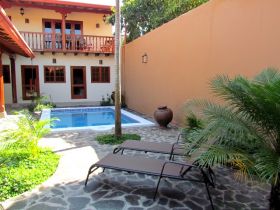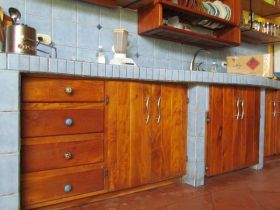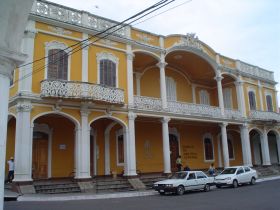What are the construction standards in Granada, Nicaragua?
John-Marc Gallagher - GPS Real Estate
 Construction standards in Granada, Nicaragua are all over the board.
Construction standards in Granada, Nicaragua are all over the board. It depends on whose standards you are referring to.
The national and city's standards are similar to ours in the USA: Architectural plans with all the structural, plumbing, electric loads signed off by licensed structural engineers and civil engineers are mandatory. But there is little to no follow up by city inspectors so the builder can...
 Construction standards in Granada, Nicaragua are all over the board.
Construction standards in Granada, Nicaragua are all over the board. It depends on whose standards you are referring to.
The national and city's standards are similar to ours in the USA: Architectural plans with all the structural, plumbing, electric loads signed off by licensed structural engineers and civil engineers are mandatory. But there is little to no follow up by city inspectors so the builder can get a way with a lot of substandard material and work. So don't let the city tell you that your house is built to standards because it may not have been once the work actually begins and ends.
Lots of contractors take short cuts to save either themselves or you money and that sometimes translates into challenges in the future.
One of the most common challenges is electricians not grounding outlets and plugs and also using a gauge of wire under the  recommended standard: say using 12 gauge when the plans call for 10 gauge. They simply don't understand the difference since in their homes, they have 3-4 40 watt light bulbs, a small TV and a stereo and it is all connected loosely with 14 gauge wire spiced together with three different colors, not grounded and working just fine!
recommended standard: say using 12 gauge when the plans call for 10 gauge. They simply don't understand the difference since in their homes, they have 3-4 40 watt light bulbs, a small TV and a stereo and it is all connected loosely with 14 gauge wire spiced together with three different colors, not grounded and working just fine!
 recommended standard: say using 12 gauge when the plans call for 10 gauge. They simply don't understand the difference since in their homes, they have 3-4 40 watt light bulbs, a small TV and a stereo and it is all connected loosely with 14 gauge wire spiced together with three different colors, not grounded and working just fine!
recommended standard: say using 12 gauge when the plans call for 10 gauge. They simply don't understand the difference since in their homes, they have 3-4 40 watt light bulbs, a small TV and a stereo and it is all connected loosely with 14 gauge wire spiced together with three different colors, not grounded and working just fine! But with a good contractor who has trained his crew to US standards, you won't be plagued by the past inconsistencies and challenges.
Building is easy and not the headache you would think it was even from 2,000 miles away. Almost all of my clients built from afar and can attest to the ease of having it completed on time and to their satisfaction... And to standard!
Posted February 9, 2014
Carlos Roman Gutierrez Solis - Casa Granada Properties
 Like everywhere else, if you are going to build in Granada, you have to secure paperwork and go through the process. You have to go to the City Hall, explain exactly what you’re planning to do, describe the building, and then bring your architect with you. You have to follow a building code. Then you make a summation of the cost of building.
Like everywhere else, if you are going to build in Granada, you have to secure paperwork and go through the process. You have to go to the City Hall, explain exactly what you’re planning to do, describe the building, and then bring your architect with you. You have to follow a building code. Then you make a summation of the cost of building. The code of construction here is similar to other places such as you will need to use reinforced walls,...
 Like everywhere else, if you are going to build in Granada, you have to secure paperwork and go through the process. You have to go to the City Hall, explain exactly what you’re planning to do, describe the building, and then bring your architect with you. You have to follow a building code. Then you make a summation of the cost of building.
Like everywhere else, if you are going to build in Granada, you have to secure paperwork and go through the process. You have to go to the City Hall, explain exactly what you’re planning to do, describe the building, and then bring your architect with you. You have to follow a building code. Then you make a summation of the cost of building. The code of construction here is similar to other places such as you will need to use reinforced walls, columns to support the structure, etc. City Hall will have an inspection and make sure that you are following the building regulations.
Unlike other places in Nicaragua, if you are in Granada, you have to understand the zoning because there are some restrictions if you are building in the historical center. But if you not building in the historical district, then you are pretty much allowed to build any kind of design, such as contemporary, modern homes, etc. You don’t have to follow the colonial style as you would if you were building in the historical district. If you are building in the historical district, then you should respect the colonial façade of the building though you don’t have to use adobe anymore but you have to recreate or replicate the very simple design. You have to use colonial architecture, tiles, wooden doors, etc. There is a code that the City Hall would require you to follow such as seismic columns and footings, septic systems, electrical wiring systems, 220 voltage or 110 voltage, etc.
Everything that you do in your building is going to be followed by an inspection from the city. Also, the fire department and the city architectural department will review your plans and they will tell you if there is something wrong or non-compliant. That is why it is very important to hire an architect who is familiar with the building requirements of the city. Sometimes if you come from another city and you bring in your architect who is also from another city, they may have some trouble understanding the city building requirements. You should have an architect who can at least guide you on the building process in the city of Granada. That can save you a lot of time.
Right now, I am building four houses in the colonial district so my architect has to follow some basic regulations. We are basically copying a colonial façade. It is a half-acre plan and we have to submit the blueprints, the engineering design, the plumbing designs, the water disposal system, what kind of septic system we are using, etc. The city has a specific code for these systems. Your architect should read these regulations and adapt them to your project. That way, you won’t have a disagreement with the city and you could continue working on your project.
The cost for these building permits is affordable. It cost me US $1,500 per unit and I am building a 1,400 square feet and a 1,500 square feet home. It’s easy. The permit is good for 6 months and you could renew the permit for about $40 for another year in case you cannot start building right away. That is very important. If you have your property and you request a building permit, you submit all the requirements, and then you get your documents ready to go, but you don’t start building right away, that is not a problem at all. You can actually have the property, buy the building permits, and decide to start building later. If that building permit expires, your architect or you can go back to the city and renew the permit for another year.
(Colonial building in Granada, Nicaragua, pictured.)
Posted June 30, 2016
Miguel Moran
One of the things that you need to know if you're buying a home in Granada, Nicaragua is that when the property is within the historical center of the town, there are a lot of regulations as to what you can do with the house. Construction in the center of town is very highly regulated.
All of the old houses in the historical center of the town are made of adobe, which is the building technique that they did 200 or 300 years ago where they mixed clay, weed, and other materials....
All of the old houses in the historical center of the town are made of adobe, which is the building technique that they did 200 or 300 years ago where they mixed clay, weed, and other materials....
One of the things that you need to know if you're buying a home in Granada, Nicaragua is that when the property is within the historical center of the town, there are a lot of regulations as to what you can do with the house. Construction in the center of town is very highly regulated.
All of the old houses in the historical center of the town are made of adobe, which is the building technique that they did 200 or 300 years ago where they mixed clay, weed, and other materials. These adobe houses usually cannot be brought down. If you do bring down one of the adobe houses, you need to build using materials that would match the house that used to be there.
If you go out to the outskirts of Granada, then you have an open building code. You could build whatever you want, any way you want.
If you are buying an old home, you need to have it thoroughly inspected. Most of the old homes, especially the ones owned by Nicaraguans, have had very little maintenance. I know people who bought homes who started to fix one thing, but this thing leads them to another thing and you could end up fixing stuff all the time. Once you touch one wall of old houses, the others tend to move. Get an engineer to check the walls and see if the house needs reinforcement or not.
If you're building in the outskirts of Granada, the best thing to do is to buy a lot, then build a house because you might not be able to get nicer homes outside of the historical center of town.
All of the old houses in the historical center of the town are made of adobe, which is the building technique that they did 200 or 300 years ago where they mixed clay, weed, and other materials. These adobe houses usually cannot be brought down. If you do bring down one of the adobe houses, you need to build using materials that would match the house that used to be there.
If you go out to the outskirts of Granada, then you have an open building code. You could build whatever you want, any way you want.
If you are buying an old home, you need to have it thoroughly inspected. Most of the old homes, especially the ones owned by Nicaraguans, have had very little maintenance. I know people who bought homes who started to fix one thing, but this thing leads them to another thing and you could end up fixing stuff all the time. Once you touch one wall of old houses, the others tend to move. Get an engineer to check the walls and see if the house needs reinforcement or not.
If you're building in the outskirts of Granada, the best thing to do is to buy a lot, then build a house because you might not be able to get nicer homes outside of the historical center of town.
Posted December 22, 2017


